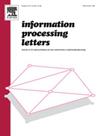证明Quickhull精度猜想的Quickhull凸包算法的下界
IF 0.6
4区 计算机科学
Q4 COMPUTER SCIENCE, INFORMATION SYSTEMS
引用次数: 0
摘要
快速包算法是一种构造n个点的凸包的简单算法。快速壳通常被描述为平面上的点,在这种情况下,它被定义为分治算法,其中有一对点(p,r),使得p和r都在凸壳上,然后找到距离直线pr最远的点q,它也必须在凸壳上,然后用三角形(p,q,r)来划分剩下的点,递归地解决所得到的子问题。众所周知,Quickhull的最坏情况运行时间为Θ(n2),但对于某些输入分布,它的运行速度要快得多。在一篇被大量引用的论文中,Barber、Dobkin和Huhdanpaa推测,当输入点的精度为O(log log n)时,Quickhull算法在最坏情况下运行O(nlog (h))时间内,h是凸包的大小。在本文中,我们给出了一个显式的下界构造,表明一般情况下,Quickhull算法的最坏情况运行时间为Θ(nh)。我们的下界证明也为Barber等人的Quickhull精度猜想提供了一个反例,因为我们给出了一个明确的结构,S, n个点的精度为O(log ln n),使得h为O(log ln n),但Quickhull在S上的最坏情况运行时间为Θ(nh),而不是O(nlog ln h)。本文章由计算机程序翻译,如有差异,请以英文原文为准。
A lower bound for the Quickhull convex hull algorithm that disproves the Quickhull precision conjecture
The Quickhull algorithm is a simple algorithm for constructing the convex hull of a set of n points. Quickhull is usually described for points in the plane, in which case it is defined as a divide-and-conquer algorithm, where one has a pair of points such that p and r are on the convex hull, and one then finds the point, q, farthest from the line , which must also be on the convex hull, and then uses the triangle to divide the remaining points and recursively solve the resulting subproblems. It is well-known that Quickhull has a worst-case running time of , but it runs much faster than this for some input distributions. In a highly cited paper, Barber, Dobkin, and Huhdanpaa conjecture that the Quickhull algorithm runs in worst-case time, where h is the size of the convex hull, when the input points have precision . In this paper, we give an explicit lower-bound construction that shows that, in general, the worst-case running time of the Quickhull algorithm is . Our lower bound proof also provides a counter-example to the Quickhull precision conjecture of Barber et al., in that we give an explicit construction of a set, S, of n points with precision such that h is but the worst-case running time of Quickhull on S is , not .
求助全文
通过发布文献求助,成功后即可免费获取论文全文。
去求助
来源期刊

Information Processing Letters
工程技术-计算机:信息系统
CiteScore
1.80
自引率
0.00%
发文量
70
审稿时长
7.3 months
期刊介绍:
Information Processing Letters invites submission of original research articles that focus on fundamental aspects of information processing and computing. This naturally includes work in the broadly understood field of theoretical computer science; although papers in all areas of scientific inquiry will be given consideration, provided that they describe research contributions credibly motivated by applications to computing and involve rigorous methodology. High quality experimental papers that address topics of sufficiently broad interest may also be considered.
Since its inception in 1971, Information Processing Letters has served as a forum for timely dissemination of short, concise and focused research contributions. Continuing with this tradition, and to expedite the reviewing process, manuscripts are generally limited in length to nine pages when they appear in print.
 求助内容:
求助内容: 应助结果提醒方式:
应助结果提醒方式:


